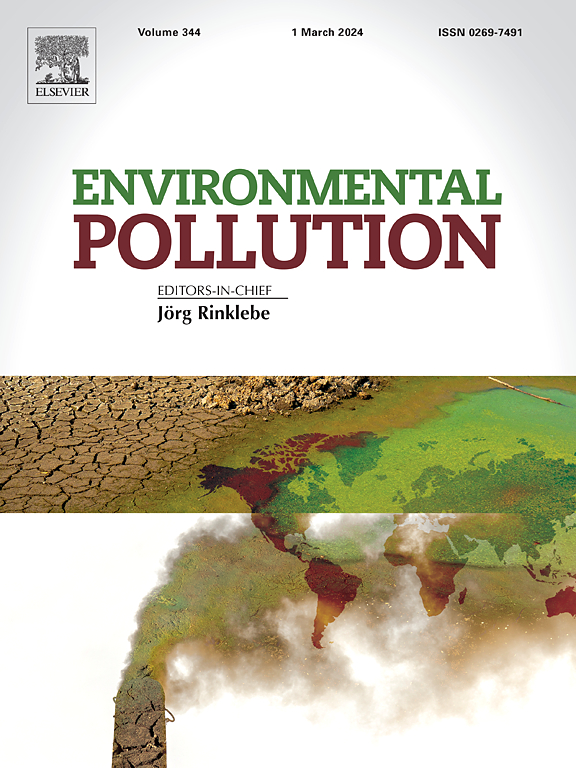Toxic effects of polystyrene microplastics on atrazine in zebrafish: Exogenous toxicity and endogenous mechanism
IF 7.6
2区 环境科学与生态学
Q1 ENVIRONMENTAL SCIENCES
引用次数: 0
Abstract
The ubiquitous presence of microplastics and other contaminants in the environment poses a potential threat to organisms, yet the mode of action and mechanisms of toxicity when they are co-exposed remain underexplored. In this work, we investigated the combined effects of environmental concentrations of polystyrene (PS) and dry heat-UV-bioaged polystyrene microplastics (CPS) with the triazine herbicide atrazine on zebrafish. Acute toxicity experiments demonstrated that combined exposure of PS/CPS and atrazine enhanced the 96-h LC50 of atrazine. Long-term exposure experiments showed that combined exposures were more likely to result in tissue damage and oxidative stress disorders in the zebrafish gut and liver. Interestingly, our experiments show that co-exposure also affects exogenous water quality by decreasing dissolved oxygen and increasing NH3+-N, NO3− and NO2− in the water column, and that NO2− and NH3+-N can cause damage to zebrafish. Moreover, the combined exposure was more likely to cause changes in gut flora at the level of phylum. In terms of hepatic gene transcription, combined exposure not only led to a significant enrichment of pathways for amino acid metabolism, fat digestion and absorption, and fatty acid degradation, but also affected several disease-associated signaling pathways. These findings provide novel perspectives and evidence on the mechanisms of toxicity induced by combined exposure to new contaminants and provide guidance for ecological risk assessment.

聚苯乙烯微塑料对斑马鱼阿特拉津的毒性作用:外源性毒性和内源性机制
微塑料和其他污染物在环境中无处不在,对生物构成潜在威胁,但它们共同暴露时的作用方式和毒性机制仍未得到充分研究。本文研究了聚苯乙烯(PS)和干热-紫外生物老化聚苯乙烯微塑料(CPS)与三嗪类除草剂阿特拉津的环境浓度对斑马鱼的联合影响。急性毒性实验表明,PS/CPS与阿特拉津联合暴露可提高阿特拉津的96-h LC50。长期暴露实验表明,联合暴露更有可能导致斑马鱼肠道和肝脏的组织损伤和氧化应激障碍。有趣的是,我们的实验表明,共暴露还通过降低水柱中溶解氧和增加水体中NH3+- n、NO3-和NO2-来影响外源水质,并且NO2-和NH3+- n会对斑马鱼造成伤害。此外,联合暴露更有可能引起肠道菌群在门水平上的变化。在肝脏基因转录方面,联合暴露不仅导致氨基酸代谢、脂肪消化吸收和脂肪酸降解途径的显著富集,而且影响了几种疾病相关的信号通路。这些发现为研究新污染物联合暴露的毒性机制提供了新的视角和证据,并为生态风险评估提供了指导。
本文章由计算机程序翻译,如有差异,请以英文原文为准。
求助全文
约1分钟内获得全文
求助全文
来源期刊

Environmental Pollution
环境科学-环境科学
CiteScore
16.00
自引率
6.70%
发文量
2082
审稿时长
2.9 months
期刊介绍:
Environmental Pollution is an international peer-reviewed journal that publishes high-quality research papers and review articles covering all aspects of environmental pollution and its impacts on ecosystems and human health.
Subject areas include, but are not limited to:
• Sources and occurrences of pollutants that are clearly defined and measured in environmental compartments, food and food-related items, and human bodies;
• Interlinks between contaminant exposure and biological, ecological, and human health effects, including those of climate change;
• Contaminants of emerging concerns (including but not limited to antibiotic resistant microorganisms or genes, microplastics/nanoplastics, electronic wastes, light, and noise) and/or their biological, ecological, or human health effects;
• Laboratory and field studies on the remediation/mitigation of environmental pollution via new techniques and with clear links to biological, ecological, or human health effects;
• Modeling of pollution processes, patterns, or trends that is of clear environmental and/or human health interest;
• New techniques that measure and examine environmental occurrences, transport, behavior, and effects of pollutants within the environment or the laboratory, provided that they can be clearly used to address problems within regional or global environmental compartments.
 求助内容:
求助内容: 应助结果提醒方式:
应助结果提醒方式:


